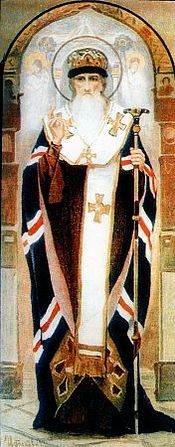Saint Ephraim of the Caves, Bishop of Pereyaslavl, before his tonsure into monasticism, was treasurer and steward of household affairs at the court of the Kiev Great Prince Izyaslav (Demetrius) Yaroslavich (1054-1068). Weighed down by this noisy and bustling life and wishing to become a monk, he was accepted by Saint Anthony of the Kiev Caves and was tonsured by Saint Nikon (March 23).
The enraged prince demanded that Ephraim return, threatening to lock him up in prison and to destroy the Monastery of the Caves. Saint Anthony and the brethren left the monastery and decided to go to another place. Izyaslav, however, feared the wrath of God. He took his wife’s advice and withdrew his forces from the monastery in disgrace.
Saint Ephraim wished to go on pilgrimage to the holy places abroad. With the blessing of Saint Anthony, he journeyed to Constantinople and settled there in one of the monasteries. While in Constantinople, Saint Ephraim made a copy of the Studite monastic Rule, and took it to Kiev at the request of Saint Theodosius. As soon as he received the Rule, Saint Theodosius implemented it in his monastery.
After the year 1072 Ephraim was made bishop in Pereyaslavl, with the title of Metropolitan. He adorned Pereyaslavl with many beautiful churches and public buildings, and he built stone walls around the city in the Greek manner. He built free hospices for the poor and travelers, and constructed several public bath-houses.
In the year 1091, Saint Ephraim participated in the opening and solemn transfer of the relics of Saint Theodosius. A Life of Saint Ephraim existed in former times, but it has not survived. We find an account of him both in the Life of Saint Theodosius, and in the Russian Chronicles. A tale and encomium for Saint Nicholas the Wonderworker is ascribed to Saint Ephraim.
Saint Ephraim died in the year 1098. He was buried in the Antoniev (Far) Caves of the Kiev Caves monastery.
His memory is also celebrated on September 28 and on the second Sunday of Great Lent.

